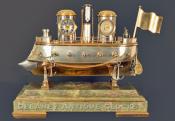French Industrial Series. The "Battleship." A novelty desk clock. Mantel clock. 218094.
This clock represents the final period of wonderfully made automata that featured clocks from 1850 to 1914. Many of these clocks were made in Paris, where they were very popular. The giant in the industry was André Romain Guilmet. His French firm made a series of clocks with industrial themes. Many of his case designs celebrated the accomplishments of the industrial revolution. Popular themes included various steam engines of varying designs, sizes, and instruments of travel that included automobiles, boats, submarines, and industrial manufacturing equipment. This is one of the more complex examples manufactured. It is in the form of a battleship.
This impressive version features nautical themes, including a gilt and silvered-bronze case in the form of an iron-hulled boat. Its' keel is brass and joins the silvered section of freeboard at the water line. Ten cannon are mounted through the sides of the hull in this location. Five are positioned on each side. A chain is mounted along the sides and across the bow. Its' purpose is to aid in the visual depth and or shape of the case. It forms a marker for the sides of the boat as they extend below the water line. It hangs freely, illustrating the hull's shape below the water line. The bow is reinforced with the applied battering ram that terminates at a sharp point. At the stern are the screw/propeller and the rudder. The clock-works automates the screw. This turns in a clockwise direction when powered by the movement. The rudder also serves the purpose of an on / off switch. It is designed to be moved by one's hand. Set at a turned position, and it will prevent the screw from rotating. Straighten the rudder out, and it is full steam ahead. The screw turns. (Supper neat.) The railings are mounted to the outer edges of the deck. The bow and stern railings are of solid construction. The railings on the sides are in the post and chain form. Four chalks secure the anchor chains to the deck. Each chain is connected to its' own large anchor. Also fitted on the deck from the bow to the stern are a capstan, a turret, two funnels, an additional turret, a steering wheel, and a stern flag. On the top of the capstan is a working compass. The two funnels are secured with chains. A Fahrenheit thermometer is mounted on one. The other has a Centigrade thermometer affixed to it. The forward turret is fitted with an 8-day spring-driven clock on one side. The dial is formatted with a silvered chapter ring and a gilt-bronze center. The hours are Roman style. Two additional cannons are mounted on the back side of this turret. Two additional guns are also mounted to the back of the second turret. This turret is fitted with an aneroid barometer in place of a clock. This dial also has a silvered chapter ring with a gilt-bronze center, steel-cut indicator hand, and beveled glass. Both of these turrets are automated. They turn with the screw and are powered by the same movement. As a result, the clock is almost always in the correct position for viewing. If it isn't, wait a few seconds, and the dials will rotate to face you. The boat's steering wheel is well-formed. It is a spoked design and features five handles and axle chains. The wheel is mounted on its' own pedestal. The flag mounted to the stern is brass and made in such a way that it appears to be moving in the wind.
The boat is mounted on a Brazilian green onyx base. This is substantial and is fitted with brass trimmings in the form of feet that elevate it off the table surface and a brass beading that defines the moldings. Very nice.
Dimensions: To the top of the stern flag, this boat is approximately 15 inches tall. The base is 18.15 inches long and 7.5 inches wide.
For additional information about this clockmaker, please read Derek Roberts' book titled "Mystery, Novelty and Fantasy Clock."
Inventory number 218094.
André Romain Guilmet was born on the 10th of December 1827 in La Ferté-Gaucher, France. He is best in the world of horology as a manufacturer of mystery clocks and clocks that feature an industrial theme. He is also credited as a watchmaker and inventor. He applied for several patents for designs. One of the more well-known applications relates to the bicycle. It was his idea to put the driving chain below the seat. His most popular "mystery clock" (mysteries with glass pendulum) was that of a woman who held a pendulum in her outstretched hand and arm. She is usually positioned standing on a marble base with a clock below. The pendulum is impulsed by the mechanism underneath her that moves the figure imperceptibly from side to side. The industrial series of clocks features automated clocks in the form of windmills, lighthouses, automobiles, boats, steam hammers, boilers, etc. All of which are excellent quality.
For additional information about this clockmaker, please read Derek Roberts' book titled "Mystery, Novelty and Fantasy Clock."












